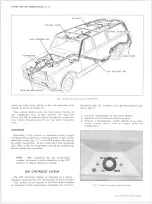
LUBRICATION 0-11
2, and 3 a sufficient number of times until the drained
liquid is colorless.
5. Allow system to drain completely and then close
radiator drain valve tightly.
6. Add the necessary amount of high quality inhibited
glycol base coolant meeting GM Specification 1899-M
to provide the required freezing and corrosion pro
tection (at least to 0°F.)
7. Run engine until normal operating temperature is
reached.
8. Check and adjust level of coolant after system has
cooled sufficiently to remove radiator cap.
The freeze protection should be at a level commen
surate with the temperatures which may occur in the
area in which the vehicle will be operated. Regardless
of whether freezing temperatures are or are not ex
pected, cooling system protection should be maintained
at least to 0°F. to provide adequate corrosion protection.
When adding solution due to loss of coolant for any reason
or in areas where temperatures lower than -20°F. (-32°F
in Canada) may occur, a sufficient amount of an ethylene
glycol base coolant meeting GM Specification 1899-M
should be used.
NOTE:
Alcohol or methanol base coolants or
plain water are not recommended for your ve
hicle at any time.
The coolant level should be approximately one inch be
low bottom of the filler neck when engine is cold. DO
NOT OVERFILL.
CAUTION:
When the engine is at normal oper
ating temperature or above, the internal pres-
sure built up in the cooling system will blow out
scalding fluid and vapors if the radiator cap is
suddenly removed. To prevent loss of coolant
and to avoid the danger of being burned, the cool
ant level should be checked or coolant added
only when the engine is cool. If the cap must be
removed when the engine is hot, place a cloth
over the cap and rotate the cap slowly counter-
clockwise to first stop and allow pressure to
escape completely. Then turn cap again slowly
counterclockwise to remove.
NOTE:
Do not remove the radiator cap when
engine is excessively hot, do not put water in an
overheated engine, and do not run engine when
indicator is above “ H” or red indicator light
comes on.
Thermostat
The cooling system is protected and controlled by a
thermostat installed in the engine coolant outlet to main
tain a satisfactory operating temperature of the engine.
This thermostat is designed for continuous use through
both winter and summer and need not be changed sea
sonally.
Radiator Pressure Cap
The radiator cap, a 15-lb. pressure type, must be in
stalled tightly, otherwise coolant may be lost and damage
to engine may result from overheating. Radiator pressure
caps should be checked periodically for proper operation.
FUEL SYSTEM
Inline Filter
Replace entire filter every 24,000 miles.
Fuel Strainer
The frame mounted fuel strainer assembly, located
between the fuel pump and fuel tank (standard equipment
on 60 Series and optional equipment on all other models)
should be replaced seasonally.
Fuel Pump
The fuel pump should be checked regularly to make
sure the mounting bolts, cover to body bolts, pulsator
diaphragm cover screws and inlet connections are tight.
Carburetor
Tighten the carburetor to manifold and the manifold to
cylinder head stud nuts to prevent air leaks. Keep the
carburetor clean externally and completely overhauled at
regular intervals.
Carburetor and Throttle Linkage
Lubricate with engine oil every 12,000 miles.
Fuel Filter Element--The gasoline fuel filter element
must be replaced in the event of carburetor flooding.
The filter element located in the carburetor inlet is to be
replaced every 12 months or 12,000 miles, whichever
occurs first.
NOTE:
When also equipped with an in-line fuel
filter, it will be necessary to change this carbu
retor fuel inlet filter only at each 24,000 mile
interval.
Governor
The attaching bolts should be kept tight, the optionally
available governor should be kept clean externally and the
filter element should be replaced every 12,000 miles.
CLUTCH A N D TRANSMISSIONS
CLUTCH
The clutch pedal free travel should be checked at regu
lar intervals.
Lubricate the clutch cross-shaft at fitting every 6000
miles with water resistant EP chassis lubricant.
Clutch and Brake Pedal Springs
Lubricate with engine oil every 6000 miles.
M A N U A L TRANSM ISSIO N S
The lubricant level in the housing should be checked
every 6,000 miles or 4 months with unit at operating
temperature. Lubricant should be level with bottom of
filler plug hole. SAE 80 or SAE 90 GL-5 gear lubricant
is recommended if additions are required to bring up
the lubricant level.
10-30 CHEVROLET TRUCK SERVICE MANUAL
Summary of Contents for 10 1971 Series
Page 1: ......
Page 96: ......
Page 100: ...10 30 CHEVROLET TRUCK SERVICE MANUAL Fig 4 10 30 Series Truck Frame FRAME 2 4 ...
Page 120: ......
Page 203: ...ENGINE 6 25 Fig 22L Engine Mounts 10 30 CHEVROLET TRUCK SERVICE MANUAL ...
Page 215: ...ENGINE 6 37 REAR M O U NT Fig 21V Engine Mounts 10 30 CHEVROLET TRUCK SERVICE MANUAL ...
Page 218: ......
Page 249: ......
Page 324: ......
Page 340: ......
Page 365: ...10 30 CHEVROLET TRUCK SERVICE MANUAL Fig 43 Power Steering Pump M ounting STEERING 9 25 ...
Page 368: ......
Page 386: ......
Page 390: ...ELECTRICAL BODY AND CHASSIS 12 4 10 30 CHEVROLET TRUCK SERVICE MANUAL ...
Page 391: ......
Page 428: ......
Page 432: ......
Page 449: ...SPECIFICATIONS 9 10 30 CHEVROLET TRUCK SERVICE MANUAL ...
Page 463: ......
Page 464: ......
Page 465: ......
Page 466: ......

































